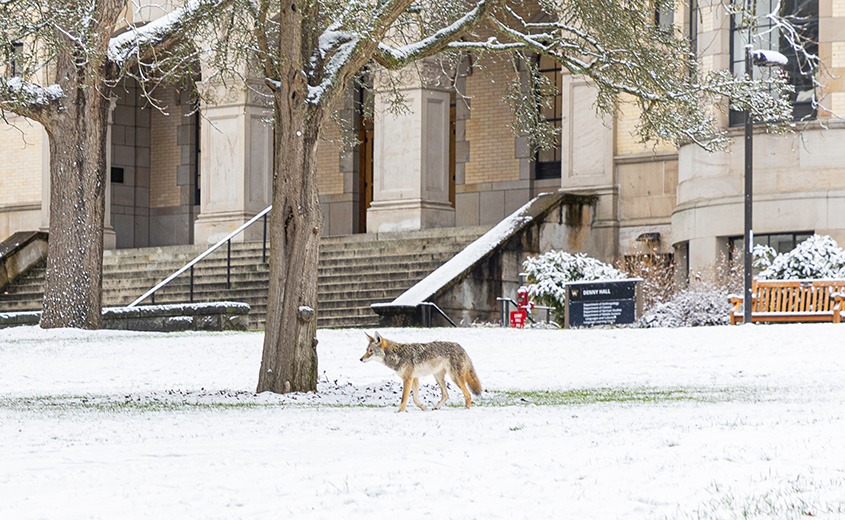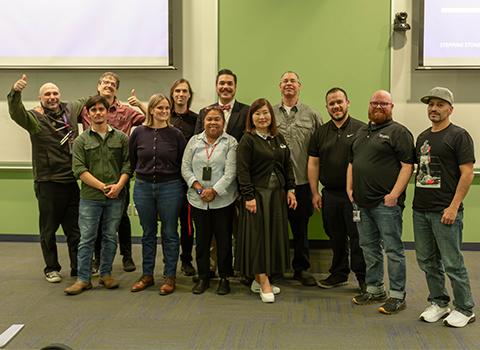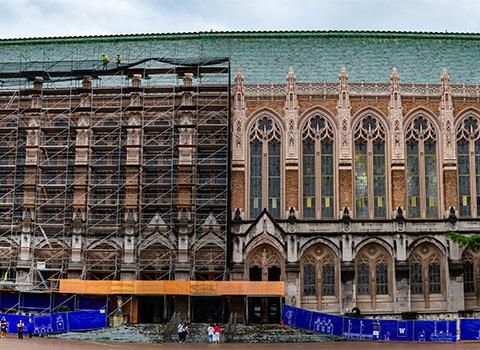Q&A: Learning about UW’s campus coyotes

A coyote near Denny Hall in December 2022. Raymond Smith
The UW campus is not only a home for higher learning, it’s also a home to wildlife. Rabbits, ducks, geese, deer, squirrels and more all enjoy the UW’s hundreds of acres of lawns, hidden gardens and green space. And then there are the coyotes.
For guidance on safely living and working around urban coyotes, read the Coyotes on Campus tip sheet from UW Environmental Health and Safety.
If you look on social media, you’ll find dozens of posts about coyote sightings on campus in the last few months. In one video, a coyote walks on a path on Memorial Drive. In another, one eats a squirrel. In another, a coyote plays with a snowman.
So why are there so many coyote sightings on campus? We went to a coyote expert for some answers.
Samantha Kreling is a doctoral student in environmental and forest sciences at the University. She researches urban wildlife diet and genetics, urban evolution, human-wildlife conflict and community science.
She also runs the Seattle Coyote Study, which collects genetic information from scat samples and carcasses found in Seattle. That information is then used to assess how many coyotes are within city limits, their sex, if they are having pups, what they eat and so on.
Misty Shock Rule: As an urban coyote expert, how much do you know about the coyotes on the UW campus?
Samantha Kreling: We've actually been able to collect a few samples, but we haven't run the genetics yet to identify which individuals they are. That being said, I have two ideas of who the coyotes are: There is a pair that in the last year or two that has kind of made Union Bay Natural Area their home base, so I think it's probably either one of them. It’s a male and female. Or they might have had pups this summer. Potentially, it's one of their pups dispersing out, and maybe it just found the campus as a nice little green spot.
Why are they coming to campus? It seems to be more frequent than in the past.
One thing I was surprised about from one year to the next is how much these family groups will move. It seems like year to year, they will choose a home base and stay there for a few months, and then shift to something slightly close, use that for a few months, and keep moving around and circling back.
So my guess is they're just trying out a new area. There are a lot of reasons they might want to be on campus. It's a pretty open area. There are a lot of natural foods for them. They're eating squirrels, rabbits, rats, lots of small mammals, an occasional bird or two, and lots and lots of fruit.
But there's also a lot of human food that could be attracting them — so things like trash left out.
I get asked a lot if more sightings mean there are more coyotes, and generally speaking, we have good reason to believe that the coyote population is relatively stable in Seattle. So I don't think there are more coyotes. I think that people are just seeing them more because they've shifted their movements.
Is it helpful for coyotes to hunt rats and rabbits? Do you consider them to be a pest?
One of my dissertation chapters is actually going to try and quantify monetarily what we gain from having coyotes in the city. The rabbits that are here are Eastern cottontails, and then the two rat species we generally see are Norway rats and black rats.
Those are all invasive species. My theory is when coyotes eat these, they're doing us a service by removing them. Because if you think about it, we are willing to pay people to get rats out of our house, and if a coyote is doing that for us, we're saving money indirectly. They also do eat a lot of fruits, so potentially they help our green spaces by spreading seeds.
I also think there's an innate benefit to having coyotes in urban areas, just in the fact that seeing nature and being in nature is something that, generally speaking, has positive impacts on human psychology and health.
What is the best way to ensure peaceful and healthy coexistence with urban coyotes?
I think the narrative on coyotes does need to change, because the media is very fearmongering, very negative. But the vast majority of interactions with coyotes are positive or neutral from a lot of other studies across urban areas. Only 1% to 2% of their diet is domestic animals, and people tend to think that it's a lot higher than that.
The second thing is making sure that coyotes are not being fed. Practically, the only time that they come into direct conflict with people and start biting things is after they've been habituated and come to associate humans with sources of food — so that can be people directly feeding them by hand, leaving food out for them, or not properly concealing trash or waste sources.
I think the third aspect is understanding a little bit of coyote behavior. Coyotes are very closely related to dogs, but their behavior is a little bit different. So a lot of people think when a dog barks it might be happy, or the dog might be barking to warn you of something. Coyotes don't really do the happy bark so much. But if you hear a kind of barking, it's also not trying to attack you. What they're doing is either communicating with each other, or they're telling you, “Hey, something is important to me over here. Please go away.”
Similarly, there's a behavior called escorting. That's when a coyote will follow a person and/or their dog. This happens a lot when people have off-leash dogs. They'll escort you away from their den site, but people often confuse that with them hunting, or a coyote stalking them, but it’s completely normal and non-threatening behavior.
What's your favorite fact about Seattle coyotes?
Pretty much every green space in Seattle — this falls apart a little bit in West Seattle, because there's just not that many coyotes right now, and we're not sure why — is somewhat occupied by a family group of coyotes.
A family group is a mom and dad and their pups of that year. In urban areas we sometimes see that older pups will stay around and help raise the younger pups as well. And that's generally because there are really abundant resources, and they don't necessarily have to disperse. While they do appear to be eating mostly natural foods, they can supplement with human food, too.
I've found some interesting things in scat samples. Sometimes it looks like they're scavenging on bald eagles. I've had cannabis come up in a couple of my samples. There's been chocolate — all sorts of things.
With so many coyotes, I’m surprised we don't see more of them.
While there are quite a lot of them here, they typically don't want anything to do with us, and I think that's something that a lot of people don't understand. A lot of the times when I'm talking to people in public, they act like coyotes are these evil harbingers just out there to eat your cats and things like that. In reality, like any wild animal, they're just trying to survive. And, if there's an easy meal, they're probably going to take it, but they do seem to mainly be eating things that are beneficial for us and natural foods.
Is there anything else we haven't talked about that you want to say about urban coyotes?
I think my hope for people is just to neutralize ideas about coyotes, because people are either fanatically in love with them — and they can do no wrong — or they're these evil, evil beings. So I hope that people converge in the middle somewhere, and we recognize that coyotes are just doing their thing like any other wildlife.



